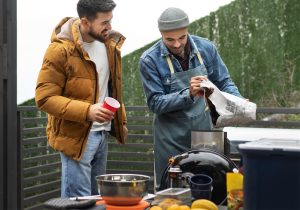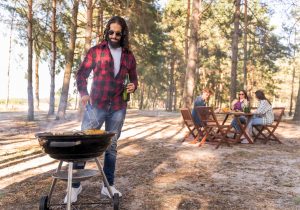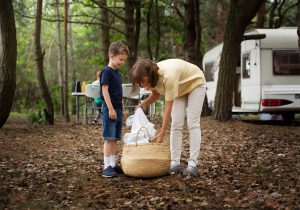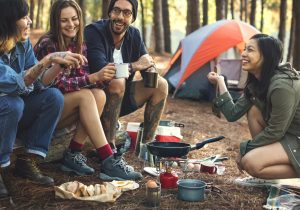Camping is an adventure, fresh air, and the great outdoors-but nothing spoils a trip quicker than rotten food or an episode of food poisoning. Whether you're an old pro at Camping or embarking on your first adventure, learning how to store and prepare food safely and keep it fresh is crucial. This complete guide will take you through each step, from packing and preparation to storage, so you can concentrate on making memories instead of worrying about your food.
Why Food Safety Matters Outdoors 
When you're in the wilderness, you don't have access to a fridge or a fully stocked kitchen. Outdoor temperatures, wildlife, and scarce resources allow food to spoil rapidly or attract unwanted critters. Bacteria grow best between 40°F and 140°F-the “danger zone”-so it's essential to keep food outside of this temperature range to avoid foodborne illness.
Planning and Packing: The Foundation of Food Safety
Choose the Right Foods 
Shelf-stable foods: Choose canned items, nuts, dried fruits, dehydrated foods, pasta, and rice. These do not need refrigeration and are less likely to go bad.
Perishables: If you take meat, dairy products, eggs, or cut veggies/fruits, arrange to keep them chilled and consume them early during your journey.
Portion wisely: Take only that amount you'll need in order to limit leftovers and waste.
Smart Packing Tips
Coolers and Ice Packs: Use a sturdy cooler with plenty of ice or frozen gel packs. Pre-chill your cooler before packing, and freeze items you plan to eat later.
Airtight Containers: Store food in airtight containers to keep it fresh and prevent odors from attracting animals.
Separation: Separate raw meat from ready-to-eat foods. When possible, use separate coolers, or if not, place raw meat on the bottom so that drips won't ruin the other food.
Warm Foods: If moving hot foods, keep them at 135°F or above and consume within four hours, or discard.
Safe Transportation 
Keep perishables cold: Keep cold foods at or below 41°F during transportation using ice or ice packs.
Preserve non-perishables: Keep away from heat and cutting objects to avoid spoilage or damage.
Temperature Check: Keep a thermometer in your cooler to monitor it at below 40°F.
Storage and Handling at the Campsite
Food Storage Best Practices
Airtight containers – Maintains freshness of food, keeps animals and insects away
Bear-proof storage – Avoids wildlife encounters and safeguards campers
Shade and insulation – Retards ice melt, keeps food cooler for longer
Separate storage areas – Minimizes cross-contamination and animal attractant
Store food in bear-proof containers or hang food in a bear bag away from the tent and cooking site of Camping in bear country.
Keep your cooler insulated: Wrap it in a blanket or tarp and keep it in the shade to extend ice longevity.
Properly dispose of scraps: Clean up promptly after meals and store waste securely.
Hygiene and Cleanliness
Hand washing: Wash hands with soap and water (not near water sources) prior to preparing food, after visiting the bathroom, and after touching raw meat.
Sanitizer: Have hand sanitizer or wipes if water isn't present.
Dishwashing: Use biodegradable soap and hot water. Wash dishes not near streams or lakes to preserve the environment.
Cooking Safely at Camp
Cook thoroughly: Utilize a food thermometer to guarantee meats are heated to safe internal temperatures (e.g., 165°F for poultry).
Avoid cross-contamination: Utilize different utensils and cutting boards for raw and cooked foods.
Eat promptly: Serve food immediately after cooking. Don't leave it out for longer than two hours, only one hour if it's above 90°F outside.
Managing Leftovers and Waste 
Chill leftovers rapidly: If you can keep them refrigerated (such as in a cooler with ice), refrigerate leftovers as soon as possible. Otherwise, they should be discarded.
Throw out suspect food: When in doubt, throw it out. If the ice in your cooler has melted or you've left food out for more than a couple of hours, don't take the chance.
Pack out all trash: Never discard food scraps or packaging. This protects wildlife and maintains the environment.
Wildlife Safety: Safeguarding Food and Nature
Store food away from sleeping areas: Never store food in your tent. Store it in bear boxes, bear canisters, or suspended in a tree at least 100 feet away from camp.
Seal odors: Utilize odor-proof bags or containers. Clean spills and crumbs immediately. 
Obey local regulations: Certain campgrounds offer bear-proof storage use if available.
Quick Tips and Common Errors to Avoid
Do:
Pre-chill your cooler and freeze water bottles to maintain the food cooler for a longer period.
Take along a food thermometer and monitor temperatures frequently.
Wash hands and surfaces frequently, particularly after handling raw ground meats.
Store beverages and easily perishable foods in separate coolers to help minimize the frequency of opening food coolers.
Don't:
Store perishable food outside in the sun or over 40°F for over two hours (one hour if it's warm).
Don't assume all animals are repelled by packaging-use appropriate storage.
Only visual inspection is used to know whether food is safe. Employ a thermometer and time guidelines.
Sample Packing List for Safe Camping Meals 
Shelf-stable foods: canned beans, tuna, nut butter, trail mix, dried fruit
Perishable items: pre-cooked meats, cheese, eggs (if you have a cooler)
Ice/gel pack cooler
Airtight containers and resealable bags
Biodegradable soap and sponge
Food thermometer
Hand sanitizer or wipes
Trash bags
Bear-proof canister or bear bag (if in bear country)
Some Sites to buy Camping Products from :
Here we are mentioning some sites from where you can buy Jewelry from:
BassPro
Walmart
REI Co-op
The sites that we have mentioned here are some of the great ones where you can consider options for Camping from. But from these sites there is one that we adore the most which is BassPro which provides an extensive range of Camping collection to select from. Rest the decision depends on you which option you wanna go with.
Conclusion:
Camping meals are the best part of the great outdoors, but ensuring food safety and freshness takes planning and attention. By selecting the proper foods, packing intelligently, staying clean, and being a respectful wildlife visitor, you'll make every meal safe, tasty, and enjoyable.
Ready to venture out or pitch camp? Need meal suggestions, gear, or a storage answer for your next adventure? Just ask!
Buy Now